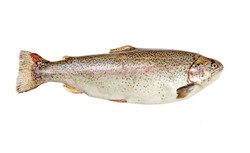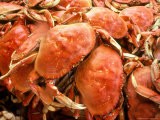We eat eggs. But one of the great delicacies is caviar, the roe, the eggs of a sturgeon. This giant fish is prevalent in the Caspian sea, and the eggs are collected from captive fish and sold on the markets. But sturgeon is not the only fish whose roe is consumed, for herring roe is also a delicacy, at its best in winter. However, some gourmets also consume the milt of the herring, which is the seminal fluid of the male fish, dried and powdered. It is said to be a delicacy. Herring roe used to be nicknamed poor man's caviar.
There is a Sardinian dish known as Botarga, which is milt and roe dried into a powder then pressed into a slab, which is then spread on pasta or toast. The roe of any fish can be used in this dish and it is said to be a delicacy, especially by the Sardinians. Yet there are fish in British waters whose roe is tasty, though there are some reservations about eating some of them. Cod and herring are popular, but pollack and ling have been used in roe dishes.
Ling is something of a problem for fishing and I have never eaten it or its roe. In the nineteenth century it was considered the poor man's cod, for it is a gaddoid, one of the cod family, and was eaten by impoverished Irish immigrants, so it became unfashionable. Lucky for the ling, as it is a large, slow growing fish, and so beam trawlers are forbidden to catch it. Small ling can be found near shore, but the large varieties, that it is permitted to catch with a line, like deep rocks and wrecks about a thousand feet down and so are impossible to trawl. Expert fishermen know where the rocks and wrecks are, but in the British Isles you are likely to find suitable water on the edge of the continental shelf off Ireland, so as I have never fished that far out there is no chance of my ever having caught a large ling. The ling has a large liver that used to be eaten with relish and its roe is tasty. But personally, I would not fish for it for ecological reasons.
There are plenty of recipes, far more than can be given in a short article, but I have listed a useful and informative work by my culinary guru, Hugh Fearnley-Whittingstall, of River Cottage fame, which contain a plethora of recipes for , as Hugh would say, fishy foodies.









 TheThousand Year Gardenon 11/26/2025
TheThousand Year Gardenon 11/26/2025
 Women of the Gospelson 10/11/2025
Women of the Gospelson 10/11/2025
 Religious Gardenson 08/25/2025
Religious Gardenson 08/25/2025
 Doctor of the Church: John Henry Newmanon 08/03/2025
Doctor of the Church: John Henry Newmanon 08/03/2025



Comments
Tartare sauce
The Primal Fear episode of NCIS: Hawai'i identifies mango sauce as a crowd-pleaser with salmon.
What would be a crowd-pleaser with salmon on your, eastern side of the (Atlantic) pond?
Yes, pilchards on a toast is an option for lunch for me too. I try for 4 fish meals during the week.
I eat only protein, no fat or carbs for breakfast so fish is useful.
Thank you for the fish-y (;-D) options, Frank and Veronica!
There are always specials on cod and tuna. But it's nice to be reminded of serving rotating dishes, like delicious haddock, salmon, sardines and shrimp (prawns on you all's side of the pond).
The only time I have had fish for breakfast was when I caught a load of mackerel in Killala Bay, in the Irish West. I don't have hard and fast rules, but we eat fish for evening meal twice a week, and I sometimes have sardines on toast at lunch. When I took Maureen for a Valentine's Day meal my starter was salmon and cream cheese pate.
I am saddened that we don't seem able to get herring anywhere near us.
How interesting that this comment is posted today. My family have been discussing fish.
I had smoked haddock for my breakfast this morning. Last week I had kippers and I know my Big Bro likes smoked mackerel pate, which I make especially for him.
For Lent, we would eat our normal fish intake .In the course of a week, I would eat ;-
1 day smoked fish for breakfast
1 day tuna sandwiches for lunch
1 day prawns and smoked salmon ( lax ) for evening dinner
I day cod for dinner
Therefore, in our household we would eat 3 or 4 fish servings a week.
Cod or smoked haddock, for me, but there are other fish possible.
Do you and your family and Veronica and hers have a certain kind of fish that you'd recommend for my Fridays in Lent? Or do you perhaps rotate through a couple? (My feline sentients observe Lent too so any fish would have to be feline-friendly ;-D).
Cheddar is a great cheese for grating and cooking.
Veronica's recipe turned out nicely. I used white sauce. What kind of cheese would I use in the gratings and sauce next time (month-end for heading into this side of the pond's beginning-September Labor Day celebrations)?